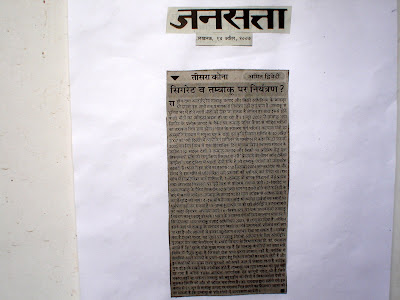Online at:
http://www.scoop.co.nz/stories/HL0704/S00325.htmAvian Influenza in Egypt
Bobby Ramakant
Scoop Independent News
New Zealand
19 April 2007
***************
"What is avian influenza?" asks a senior lady doctor working in one of the leading hospitals in Cairo. It is not a surprise because in present times we all are so focused with our own respective professions and interests, that it becomes hard to know all about all.
The Egyptian Ministry of Health and Population has announced two new human cases of avian influenza A(H5N1) virus infection. The cases have been confirmed by the Egyptian Central Public Health Laboratory and by the US Naval Medical Research Unit No.3 (NAMRU-3).
The first case, a 2-year-old female from Menia Governorate, developed symptoms on 3 April 2007 and was admitted to hospital the following day. She is currently in a stable condition. Initial investigations into the source of her infection indicate recent contact with backyard poultry.
The second case is a 15-year-old female from Cairo Governorate. She developed symptoms on 30 March 2007 and was admitted to hospital on 5 April 2007 where she remains in a critical condition.
Of the 34 cases confirmed to date in Egypt, 13 have been fatal.
Avian influenza, or "bird flu", is a contagious disease of animals caused by viruses that normally infect only birds and, less commonly, pigs. Avian influenza viruses are highly species-specific, but have, on rare occasions, crossed the species barrier to infect humans.
In domestic poultry, infection with avian influenza viruses causes two main forms of disease, distinguished by low and high extremes of virulence. The so-called "low pathogenic" form commonly causes only mild symptoms (ruffled feathers, a drop in egg production) and may easily go undetected. The highly pathogenic form is far more dramatic. It spreads very rapidly through poultry flocks, causes disease affecting multiple internal organs, and has a mortality that can approach 100%, often within 48 hours.
Influenza viruses are grouped into three types, designated A, B, and C. Influenza A and B viruses are of concern for human health. Only influenza A viruses can cause pandemics.
Influenza A viruses have 16 H subtypes and 9 N subtypes. Only viruses of the H5 and H7 subtypes are known to cause the highly pathogenic form of the disease. However, not all viruses of the H5 and H7 subtypes are highly pathogenic and not all will cause severe disease in poultry.
On present understanding, H5 and H7 viruses are introduced to poultry flocks in their low pathogenic form. When allowed to circulate in poultry populations, the viruses can mutate, usually within a few months, into the highly pathogenic form. This is why the presence of an H5 or H7 virus in poultry is always a cause for concern, even when the initial signs of infection are mild.
The current outbreaks of highly pathogenic avian influenza, which began in South-East Asia in mid-2003, are the largest and most severe on record. Never before in the history of this disease have so many countries been simultaneously affected, resulting in the loss of so many birds.
The widespread persistence of H5N1 in poultry populations poses two main risks for human health.
The first is the risk of direct infection when the virus passes from poultry to humans, resulting in very severe disease. Of the few avian influenza viruses that have crossed the species barrier to infect humans, H5N1 has caused the largest number of cases of severe disease and death in humans. Unlike normal seasonal influenza, where infection causes only mild respiratory symptoms in most people, the disease caused by H5N1 follows an unusually aggressive clinical course, with rapid deterioration and high fatality. Primary viral pneumonia and multi-organ failure are common. In the present outbreak, more than half of those infected with the virus have died. Most cases have occurred in previously healthy children and young adults.
A second risk, of even greater concern, is that the virus – if given enough opportunities – will change into a form that is highly infectious for humans and spreads easily from person to person. Such a change could mark the start of a global outbreak (a pandemic).
Direct contact with infected poultry, or surfaces and objects contaminated by their faeces, is presently considered the main route of human infection. To date, most human cases have occurred in rural or periurban areas where many households keep small poultry flocks, which often roam freely, sometimes entering homes or sharing outdoor areas where children play. As infected birds shed large quantities of virus in their faeces, opportunities for exposure to infected droppings or to environments contaminated by the virus are abundant under such conditions. Exposure is considered most likely during slaughter, defeathering, butchering, and preparation of poultry for cooking.
In areas experiencing outbreaks, poultry and poultry products can also be safely consumed provided these items are properly cooked and properly handled during food preparation. The H5N1 virus is sensitive to heat. Normal temperatures used for cooking (70oC in all parts of the food) will kill the virus. Consumers need to be sure that all parts of the poultry are fully cooked (no "pink" parts) and that eggs, too, are properly cooked (no "runny" yolks).
World Health Organization says that avian influenza is not transmitted through cooked food. To date, no evidence indicates that anyone has become infected following the consumption of properly cooked poultry or poultry products, even when these foods were contaminated with the H5N1 virus.
*************
(The author is a senior health and development journalist writing for newspapers in Asia, Middle East and Africa. He can be contacted at: bobbyramakant@yahoo.com)









